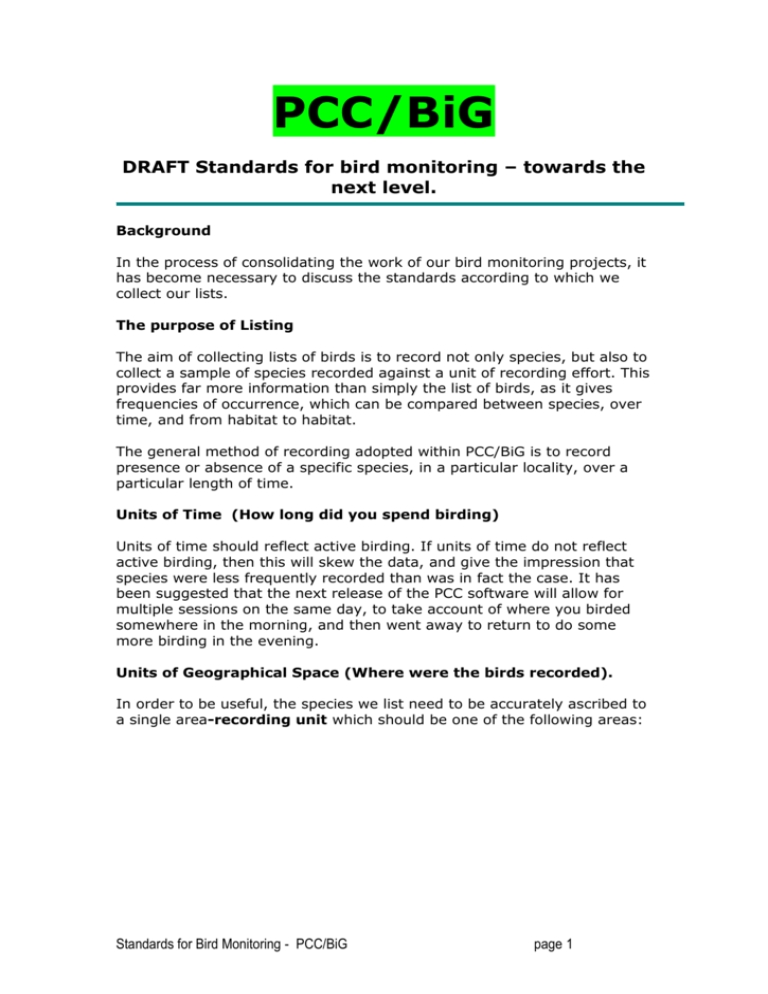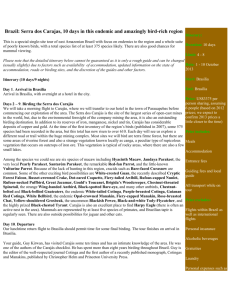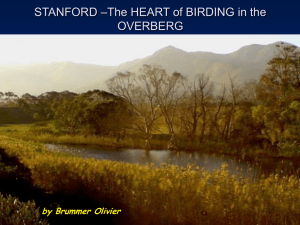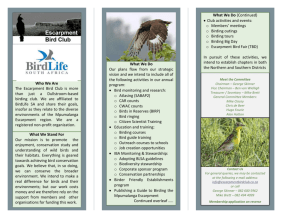Standards
advertisement

PCC/BiG DRAFT Standards for bird monitoring – towards the next level. Background In the process of consolidating the work of our bird monitoring projects, it has become necessary to discuss the standards according to which we collect our lists. The purpose of Listing The aim of collecting lists of birds is to record not only species, but also to collect a sample of species recorded against a unit of recording effort. This provides far more information than simply the list of birds, as it gives frequencies of occurrence, which can be compared between species, over time, and from habitat to habitat. The general method of recording adopted within PCC/BiG is to record presence or absence of a specific species, in a particular locality, over a particular length of time. Units of Time (How long did you spend birding) Units of time should reflect active birding. If units of time do not reflect active birding, then this will skew the data, and give the impression that species were less frequently recorded than was in fact the case. It has been suggested that the next release of the PCC software will allow for multiple sessions on the same day, to take account of where you birded somewhere in the morning, and then went away to return to do some more birding in the evening. Units of Geographical Space (Where were the birds recorded). In order to be useful, the species we list need to be accurately ascribed to a single area-recording unit which should be one of the following areas: Standards for Bird Monitoring - PCC/BiG page 1 1. The largest acceptable unit of geographical area is one quarter degree square covering an area of approximately 690 km2. (an old Atlas Square, of 15 minutes latitude by 15 minutes longitude). Quarter Degree Squares or QDS as they are known, have the notation. The red square highlighted on the right has the notation 2830CA. 2. A defined Conservation Area, with clearly definable boundaries. These would be Nature Reserves, National Parks etc. These are the conservation areas, which are available as a drop down on the PCC list. And are defined as as a whole will be defined as a single area recording unit. (e.g. Mkhombo NR.) (We recommend removing conservancies without a clearly definable boundary fence from this list, as these seem not very useful from a data gathering point of view) 3. A 3X3 Minute Grid Square. The need for such a grid size is based on the view that the standard quarter degree square (QDS) is really too large for any sort of meaningful analysis and more refined maps than those currently in the Atlas. Given the detail with which for example vegetation and land use are now being mapped, any larger scale grid will not provide sufficiently detailed distribution or population data. This grid square is derived by dividing a quarter degree square into a 3 minute grid. The new 3X3 minute grid size BirdMapping Square or BMS, is thus 1/25 of the old Quarter Degree Square unit, and covers an area of about 26km2. In the example on the left, The blue coloured grid will be notated as grid Standards for Bird Monitoring - PCC/BiG 2830CA19 page 2 4. An urban Street Address. We accept lists for an area defined by a street address, and a radius of 1km from the provided street address. Lists which are within the boundaries of a an urban property (Garden List) are defined simply by the street address (21 Muller Street Waverley, Pretoria). Lists for the street address + 1km radius should be designated by adding the word “area” onto the street description. ( 21 Muller Street, Waverley Area.) 5. Using Birding Units to Establish where you are birding. In order to enable people who do not have GPS equipment, or advanced map reading skills to utilize the new BM Squares, it is necessary to establish a protocol for the definition of “Birding Units”. The proposed protocol for establishing Birding Units is dealt with in some detail in the next section. It is proposed that an online database of Approved Birding Units be established, and that these be grouped by Geographical area. All participants who have GPS equipment, would be requested to assist in defining these Birding Units for participants in the PCC/BiG programme to make use of. This would mean that if you want to go and bird the Zaagkuildrift road, you could easily print out a sheet of the relevant Birding Units, to take with you. In terms of contributing lists it would then be easy to focus ones birding within a definable BMS. 6. How to define a birding unit. A birding unit consists of the following elements: A name. It is suggested that the name has two parts, the first being the general area, and the second being the BMS reference to which it refers. Possible names might be Zaagkuildrift_2528AA20, or Wilgevalley_2528DB15. A position (GPS waypoint). This is essential if accuracy is to be maintained. Directions on how to find it. It is thus best is the waypoint above refers to an obvious landmark, or physical structure on the ground, which is not easily confusable with any other. Instructions regarding the range of the Unit. Three types are proposed (a) distance from in any direction (radius), (b) Distance along a road in either direction, and (c) distance from the road, where a distance along a road is also provided. Standards for Bird Monitoring - PCC/BiG page 3 Table 1 Description of Birding Units Unit Type Road Unit A Road Reference Orientation Point Included Road Included off-road Describe road and direction travelling Distance from landmark, 1km, 1.5km, 2.4km Distance from Road, 200m, 500m, 1km Road Unit B Describe road and direction travelling Distance from Road, 200m, 500m, 1km Centre Point Describe area, farm, road nearby Distance from “point” along road, 1km, 1.5km, 2.4km Distance from point (radius): 1km, 1.5km, 2.4km Obvious landmark on road: bridge, stream, gate, sign, tree. Distance from intersection to “point” Obvious landmark: bridge, stream, gate, sign, tree, house Notes on Birding Units. It is proposed to use a limited number of standard distances, the largest being 2.4km for a landmark which is close to the centre of a BMS. Distances from Birding Units should either be along a road, or radius of circle, but should always be in any direction to avoid confusion. The “distance from a road” statement only comes into play when a road passes near the edge of a BMS, and is otherwise always 1km for any Birding Unit using a road as definition. Lists which will not be accepted. Given the difficulty of allocating some lists which are submitted, and which do not fall into any of the above categories, The PCC/BiG will not longer be accepting such lists. In summary, lists which will no longer be accepted include the following: Lists defined by a place name (ie Florida, Zaagkuildrift, Cullinan, Kimberley. Lists defined by a route (Dullstroom to Lydenburg) Lists defined by two localities (Roets Farm and Kgomo-kgomo) Lists defined by a birding area, which has not been registered and ratified by the PCC/BiG. This includes names such as “Road to Mdala NR, Lands outside Vaalkop, and General area lists such as Gouwsberge. Rationale for not accepting these lists. Where areas are not defined, or lists are defined by place names, which are not tied to specific grid references, or conservation areas, it becomes impossible to allocate the data entries to a meaningful location in our database. At present, the Database administrators are simply not able to go and refer to the maps, which is necessary to allocate a list (for example “Delmas”) to an actual Standards for Bird Monitoring - PCC/BiG page 4 grid reference. In any event, receipt of such lists would require further confirmation by the observer, that they knew where the boundaries of a specific area are. The way forward. In the next release of Avi-track software, which is the listing programme currently used by PCC/BiG, the list interface will make provision for entering localities based on 3X3 Grid or BMS references. Maps. In order to facilitate better use of maps, by those who do not have GPS sets, Common maps will be made available online, or via a CD, and an admin fee will be levied for these maps. Best Practise for Listing Submit lists for single 3X3 Minute squares. Use a system of field recording to log your lists. It is not good practise to try and remember the birds recorded in several different localities over a weekend. If you are not PDA enabled, use a printed list to record your birds in the field, and then transcribe them onto the PCC lists when you get back to your computer. Submit lists only for an intensive period of birding and record start and finish times exactly. If it’s not in it’s not on! If you are submitting a list for a particular locality (farm, nature reserve or defined birding area, include only those species recorded within the area. If in doubt leave it out. Speculative ID’s pose an additional burden on the vetting panel and should rather be omitted. Wherever possible use the drop down lists of localities provided. Minor spelling differences prevent the automated capture of lists that are not the exactly the same as those on record. The same applies to observer names: Eric Rautenbach and E.D. Rautenbach are not the same person as far as the computer is concerned. Glossary of Terms QDS – Quarter Degree Square BMS – Bird Mapping Square – a 3X3 minute grid square, now adopted as the standard for bird monitoring projects. Birding Units – A defined location which can be tied to a BMS in order to enable people to easily bird there. 1st draft 19 May 2004 Standards for Bird Monitoring - PCC/BiG page 5 Standards for Bird Monitoring - PCC/BiG page 6





